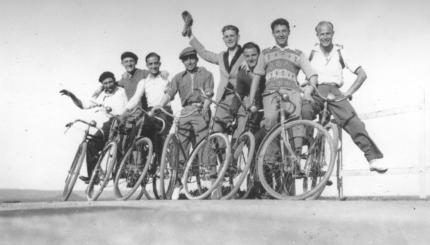Humor and folklore can say a lot about a culture–such as what is considered proper or not and who is on the inside and who is an outsider. The following article looks at the role Jews played in European and American folklore and humor. Reprinted with permission from The Jew in Early American Wit and Graphic Humor (Ktav).
In Europe, the Jew’s place in the world image of his Christian neighbors was more or less solidly defined; he was a well-known object around which their folk imagination and social humor could wind. In literature and drama the Jew was represented as the personification of evil or, later, as a figure of comedy.
 The religious antagonism, long supported by church and state, which produced such folk fantasy as the legend of the Wandering Jew, never radiated the same strength of feeling in America as was common in the Old World. From the beginning, the rebellious Protestant sects that migrated to the New World identified themselves with the Hebrews of Biblical literature: Their emphasis on the Old Testament, their attitude toward Hebrew as a holy tongue and the Hebrews as the People of the Book led to a different image than that held by their forebears in Europe–at least on the surface. For a long time, the religious notions of the founders of the American civilization so dominated the Americans’ image of the Jew that his appearance as a real member of a living contemporaneous community of people came to their consciousness only slowly and reluctantly.
The religious antagonism, long supported by church and state, which produced such folk fantasy as the legend of the Wandering Jew, never radiated the same strength of feeling in America as was common in the Old World. From the beginning, the rebellious Protestant sects that migrated to the New World identified themselves with the Hebrews of Biblical literature: Their emphasis on the Old Testament, their attitude toward Hebrew as a holy tongue and the Hebrews as the People of the Book led to a different image than that held by their forebears in Europe–at least on the surface. For a long time, the religious notions of the founders of the American civilization so dominated the Americans’ image of the Jew that his appearance as a real member of a living contemporaneous community of people came to their consciousness only slowly and reluctantly.
Real vs. Unreal Jews
The contrast between the real subjects–the Jewish people struggling for survival as a community of human beings in new times and on a new continent–and the unreal picture consisting of a mixture of the most diverse interpretations of Biblical literature, led to the wildest notions: the identification of the Indians as the Lost Ten Tribes of Israel, the importance of the conversion of the Jews as a preliminary to the redemption of the world, and continuous comparisons of various Christian sects with Judaism, all of which almost erased the real living Jew.
The separation of the Jew from his religious prototype finally came about in the American consciousness only under the pressure of the experiences gained in an America in a state of flux, turning rapidly into an urban capitalistic industrial nation after the Civil War, in which the role of the Jew became unmistakably recognizable.
American wit at the time of the build-up of this industrial society became a mirror of reality, in which the Jew appears as a driving element. Bearer of an old culture, the Jew, on the new continent, worked to find success in an environment which evaluated people according to new economic categories, newly rising. At the same time, he sought to transplant the historic values of his former community to this new world. No wonder that much that was understood in him was derided in the cruel humor of the tough, young, still-to-be conquered continent; no wonder that he was often forced into a category of beliefs which could not easily be erased even by his economic rise. The Jew was here, as nowhere in his history, on strict probation–while an amazed environment looked on.
Jews, Money, & Capitalism
Nevertheless, an important difference was already manifest at this juncture compared with his treatment in Europe. Social criticism of the Jew in capitalist America, from the beginning, became identified with a measure of self-criticism within the new society as well. The popular Biblical word-image of the Golden Calf may serve as an instance of such self-criticism: Since earliest times, the Golden Calf was used in Europe as a symbol of “Jewish mammon worship.”
In America, however, it always represented the money principle, generally. It appears in this aspect also in the crooked mirror of laughter and as the expression, also, of the discomfort felt by individuals forced to submit their cultural ideas to this impersonal principle. Thus, the image of the Golden Calf caught hold as the self-criticism of a nascent American cultural consciousness.
Caricature
To gain an inner understanding and knowledge of historical situations, although in a more indirect way, folklore is no less valuable an instrument than the wit and literary humor of the times, although admittedly, in this form it is somewhat harder to seize upon the truth. Truth in the field of wit has at its disposition a unique instrument–the caricature–which, on occasion, makes use also of the visible things of folklore, as, for example, the three balls of the pawnbroker, used as symbols in the drawings.
The value of caricature as a path to historical truth should not be underestimated. Its effects are immediate and powerful. The caricaturist is able to allow fantasy to roam freely or he can exercise self-restraint for the sake of achieving specific goals. We see this best in the classic example of the political caricature, where social reality is the artist’s first and unconditional intent.
The knowledge of the value of caricature and its general character were early understood in America. An announcement of 1839 proclaims:
“Caricature seldom stings the faller, and never handles to obscure. Once more–the caricaturist is the best historian.”
Thus, by means of caricature the deeper meaning of the symbolism of the money principle, through the Jew, is demonstrated by the use of the simple formula of the Golden Calf. Over the road of the Biblical Jew, this symbol strikingly represents the most important development in America: its changeover from an agrarian, land-oriented economy to an industrialist-creating riches, for whom land was no longer the symbol, but to whom money became a new principle which could be attacked much in the same way as the earlier mammon-service of the Jew was attacked in a still-religious Europe.


